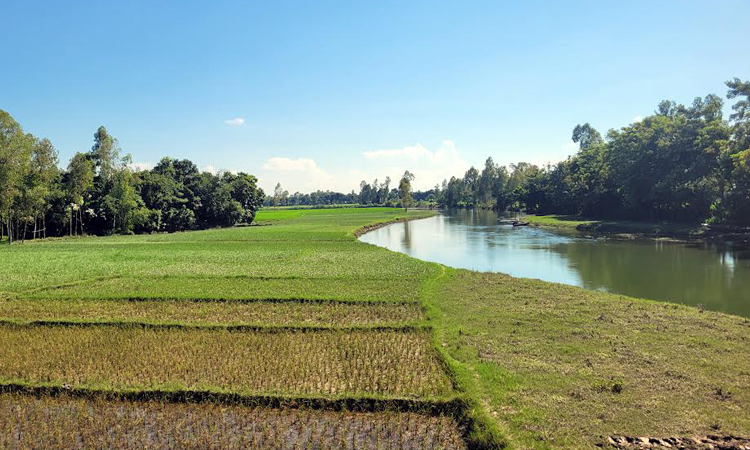News Flash
News Flash

Shafiqul Islam Bebu
KURIGRAM, Oct 03, 2025 (BSS)- Baromasia River, once known for its mighty brook round the year, has now turned into a crop field lacking flow of water.
The fisheries department has leased out some parts of the river for pisciculture, categorizing it as a closed water body or beel. However, once upon a time it was known as a Baromasia river for its all season flow.
Once boats used to sail and riverbank erosion was common. Thousands of people used to live across its banks. Fishing was common among locals. There were many stations and ghats for waterway travelers for their landing and crossing.
Locals said lack of dredging merged the river with the plain land. Climate change is also one of the reasons behind it. Fishermen now opted to cultivation in char areas. Local people use bamboo-made foot-bridge to cross the river.
The Baromasia River, originated from a lake in Indian Cooch Behar district, entered Bangladesh through Gorkamandap border of Phulbari upazila of Kurigram.
It is called the Baromasia River in Bangladesh part with a length of about 10 kilometers. The Baromasia joined the Dharla River in Sonaikaji area under Phulbari upazila.
Locals identified the ‘negligence of authorities’ as one of the main reasons for losing its existence. The existence of the river was found in the British era map. But, it has not been identified as a river in any survey of the government after British rule. Even the Baromasia River is not found in the list of 54 recognised transboundary rivers flowing from India to Bangladesh. As a result, it remains even more neglected.
During a recent visit, this correspondent found that the Baromasia River becomes a crop field. A small canal is flowing in the middle. Locals still call it Baromasia River.
Farmers produce paddy, pulses, bananas, and various vegetable on more than a hundred small chars emerged on the riverbeds. No water flow in the river made it into a three-season arable land, popular for producing aush, aman and boro crop along with various types of corns, fruits and vegetables.
Only during the monsoon, water accumulates in the low laying areas and submerges neighborhoods causing floods even in low rainfall.
Kabirul Islam of Krishnananda area is a local farmer live on the vicinity of the river. He cultivated brinjal on two bighas of land in the Baromasia char this year.
“I hope best harvesting of my crop as there was no rain this year,” he said adding he planted samplings of brinjal in advance to get good price of this produces
He also cultivated a lot of corns in the Uddin char of the Shimulbari area….the new soil is good for cultivation, he said.
Farmer Abu Hanif said the beel is feasible for multi crop culture. Asked about the problem due to lean river, Abu Hanif said, its caused problem for the fishermen, who were forced to change their occupation.
Govinda Chandra Roy of Krishnananda Bakshi area at ??Gorakhmandal said transportation is another problem for them.
The Phulbari Upazila Agriculture Office said about 15,000 hectares of arable land in the river basin, including Dharla and Baromasia, have been brought under cultivation. Farmers grow three crops a year, he said.
Locals said thousands of families lost their homes for river erosion while thousands of others have lost their water based occupation after their river dried up. Now they do various works in different places, while many boatmen now ply auto-rickshaws, he said.
Shahidul Islam, a local union parishad member, blamed local fishery office for turning the river into a drain.
“There is a water flow from the border to Intur Ghat. But fisheries department leased it out for fish farming showing it as a closed water body,” he said.
As an open water body every local people was supposed to catch fish in the river. But, now none is allowed for fishing as it has been leased out to a particular person as a beel.”
Dr Tuhin Wadud of Riverine People, a non-government organisation, said Baromasia was a big transboundary river. But, lack of maintenance caused drying up the river.
He said, the river needs to be recognised as a transboundary one. Then, if it is dredged scientifically, its flow can be restored. For this, the government needs to come forward.”
Naodanga Union Parishad Chairman Hasen Ali said local people had to suffer a lot due to death of the river. It made thousands of people unemployed.
Executive Engineer of Kurigram Water Development Board Rakibul Hasan said, "Last year, the river has been included in the list of 38 rivers in Kurigram.”
“We are currently working with the major rivers. However, we are also thinking what can be done about the small ones.”